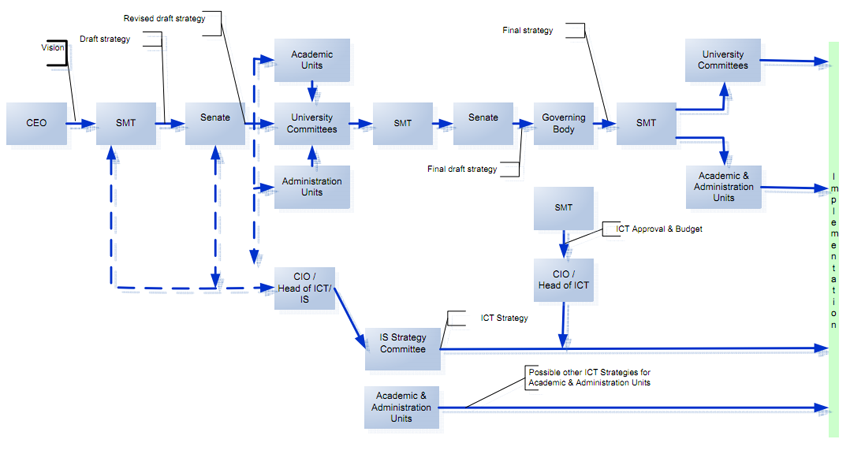2.1 The process of ICT strategy formulation in HEIs
Our research confirmed that strategy formulation is often top down with the Vice-Chancellor or equivalent identifying the vision and ethos that is then enriched by the institution's senior management team creating the draft strategy.
From this impetus the institution strategies are developed, this may include an ICT strategy. It is in this area that the heterogeneity and characteristics of institutions attract different approaches.
Given that ICT is embedded across an institutional enterprise we sought to define the processes and the current practices for ICT strategy formulation and implementation and their relationship to institutional strategies. The SICT toolkit draws on the project research into strategy formulation and implementation in HEIs, as well as international research and the substantive information previously gathered in the Duke and Jordan3 studies completed on behalf of the JISC and LFHE. This information focuses on institutional awareness, current practice, recognised good practice in ICT strategy and the issues arising in its integration with institutional strategies.
Our findings are presented using two generic models to illustrate the integrated or disjoint ICT strategy formulation practices in relation to corporate strategy. These are adapted from Duke & Jordan's models and illustrated below. We refer to these models of strategy development as either the integrated or the disjoint model.

The integrated model illustrates the development of ICT strategy co-ordinated with the development of the institutional strategies. The draft strategy that is prepared by the Senior Management Team (SMT) is used to focus and drive the development of institutional strategy through the heads of business units, across teaching and learning, research and administration.
ICT is effectively another business thread across the university but in order to produce the ICT strategy major consultation is undertaken to ensure that the ICT needs of the individual business units are jointly understood, developed and included within the ICT strategy. The ICT strategy is developed from the overriding institutional vision, academic and business unit requirements and with the professional expertise and vision of the ICT or Information Services unit. This generally occurs through the management and approval of an ICT strategy Group, normally, although not always, chaired by the Chief Information Officer (CIO) or equivalent senior ICT/IS manager.
The ICT strategy is normally submitted for approval as a specific strategy document although we found some institutions that held ICT within the business unit strategies. In summary, this approach is top down and supports institutional strategy alignment as all ICT needs are included within a single strategy and it allows implementation using operational planning and management against the strategy.

The disjoint model shows the ICT strategy developed across the central and academic units resulting in a number of ICT strategies that may not be integrated within the institutional strategy development processes and timescales. This approach is not integrated or formally aligned but can provide a visible set of ICT strategies for implementation through operational planning and management. We can use this model to illustrate the relationship of multiple strategies and even unplanned ICT on corporate strategy alignment and within operational implementation planning and management.
Duke & Jordan identified the fundamental differentiator between these models as:
'ICT and other key functional strategies come out of the corporate strategy and have as their overriding purpose the delivery of corporate strategy, or if the functional strategies are developed in a parallel process which takes cognisance of the overarching strategy but has additional independent aspirations and purpose.'
Our research into twenty institutional strategies confirmed that the level of detail within draft and approved corporate strategies varied considerably. Again there is no correct approach but we observe that this may have an influence on the balance of detail between strategy, and operational planning and implementation developed within different frameworks and timescales.